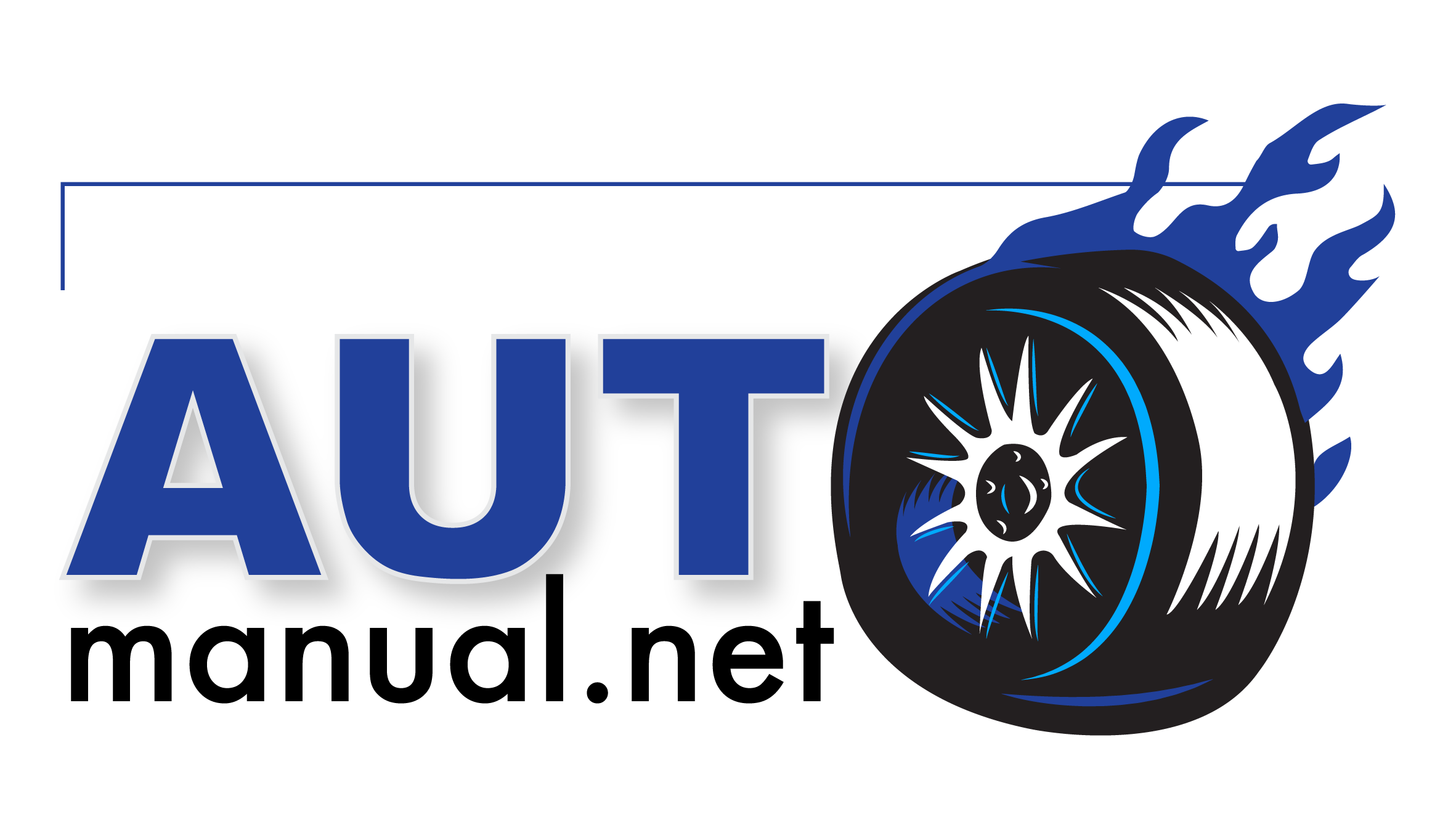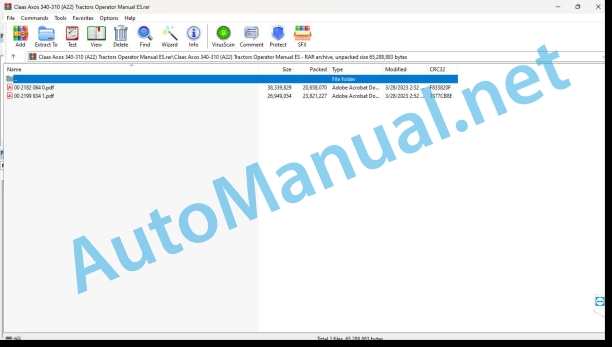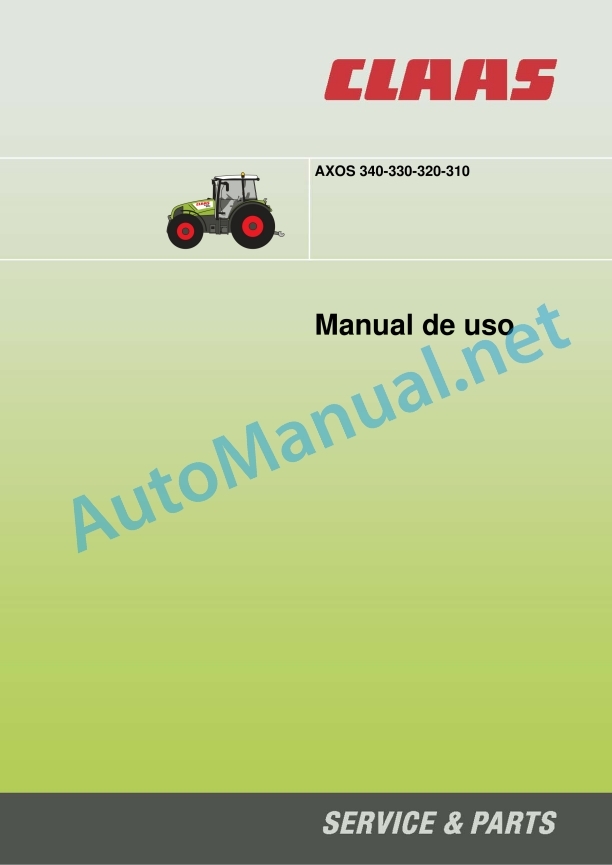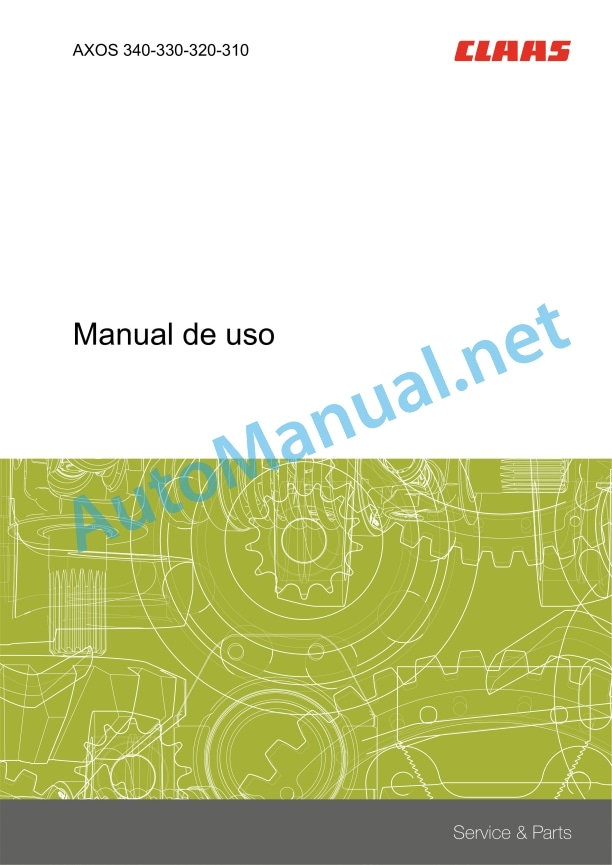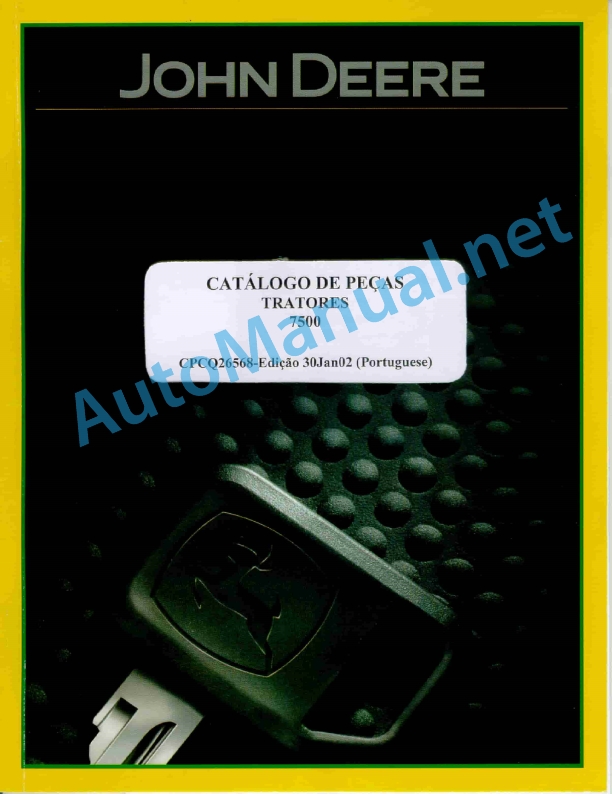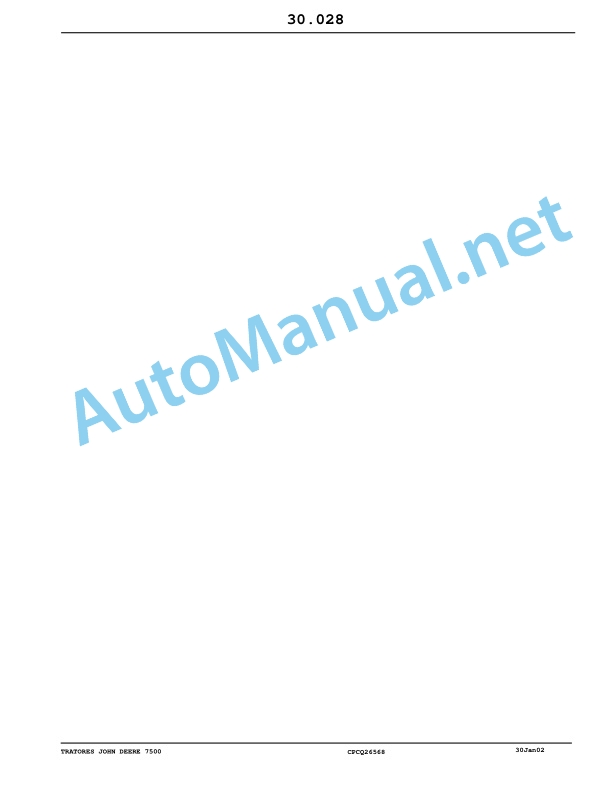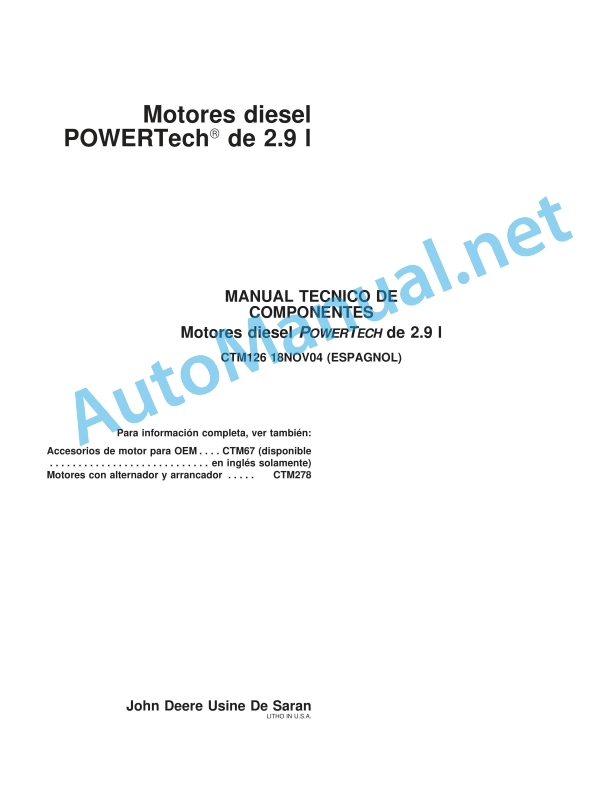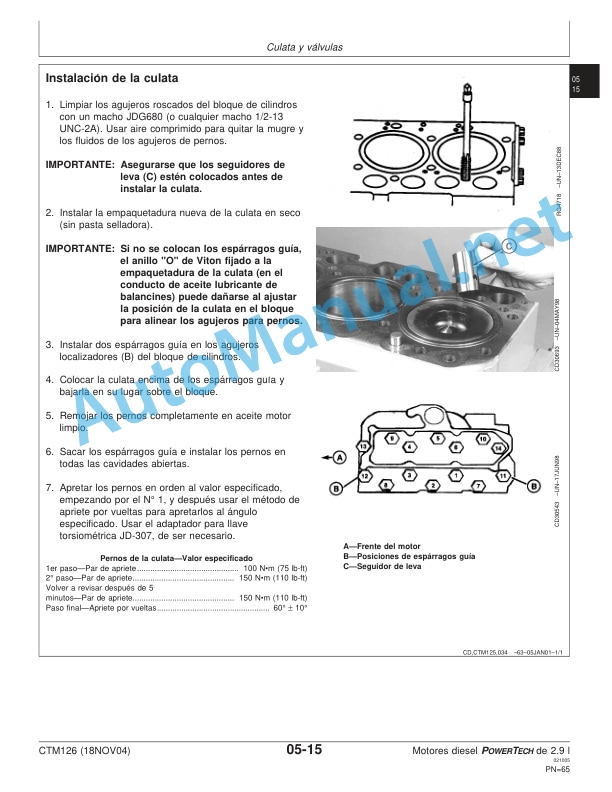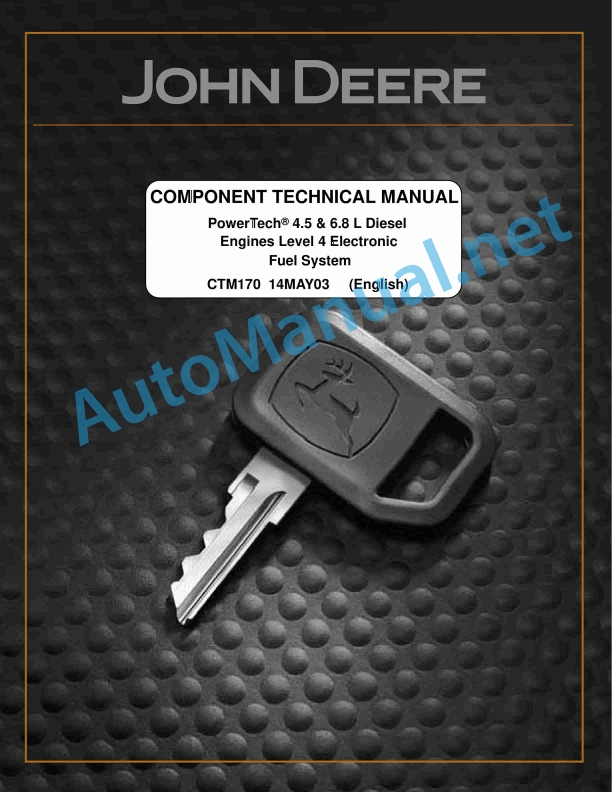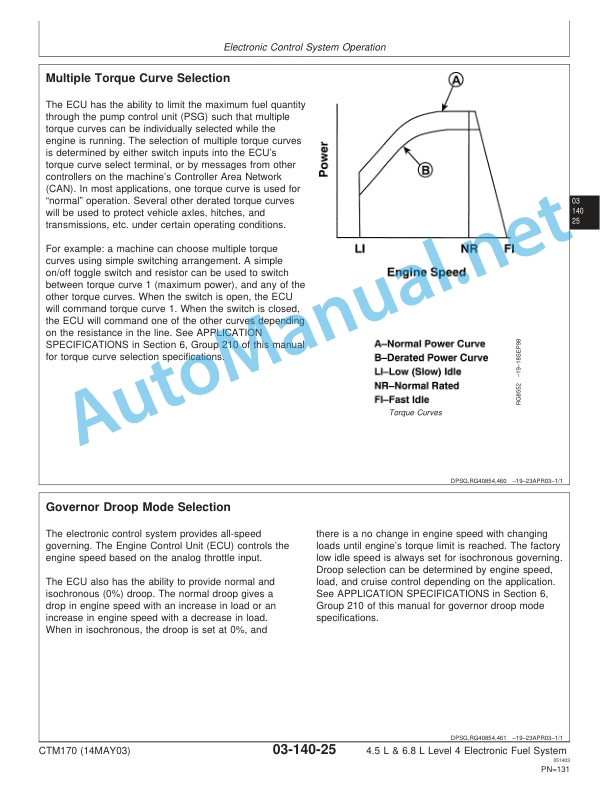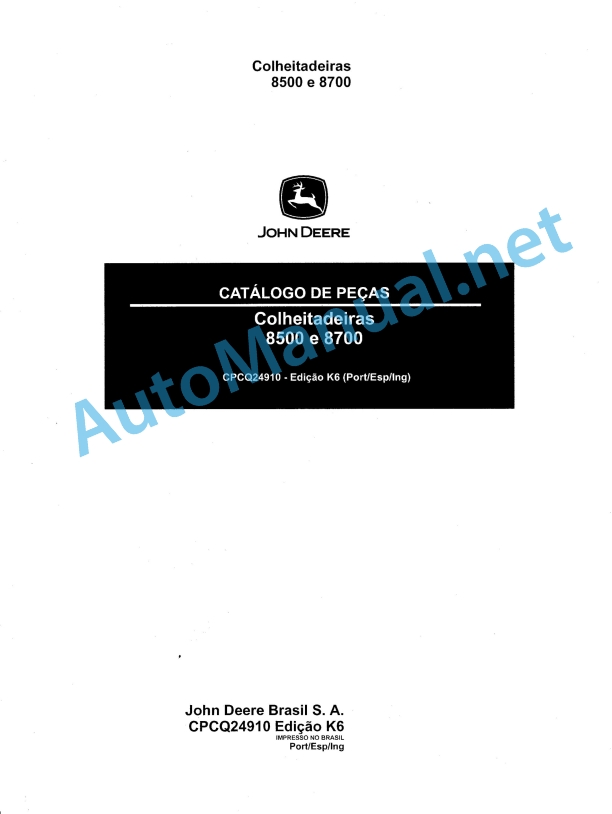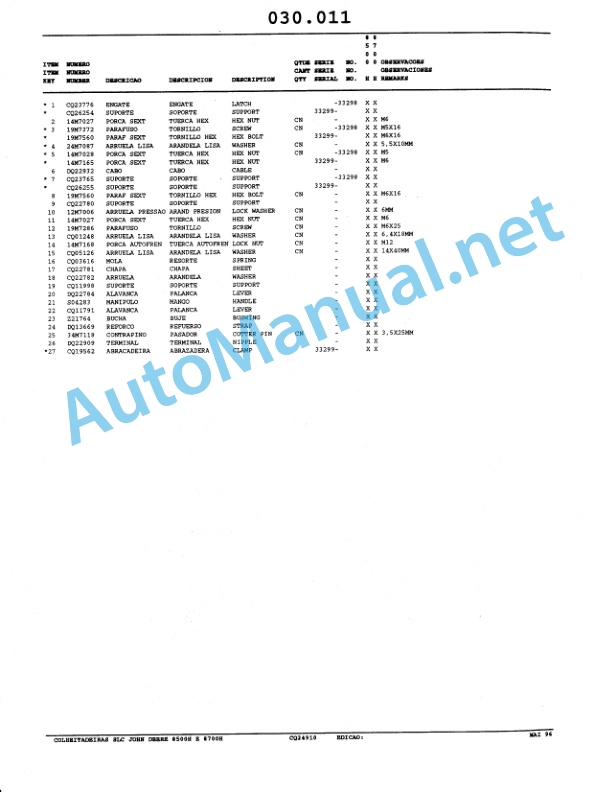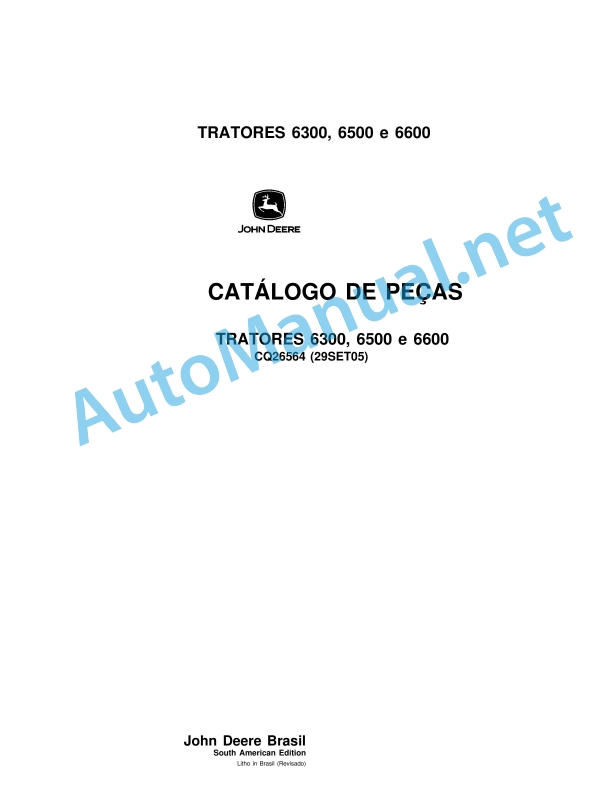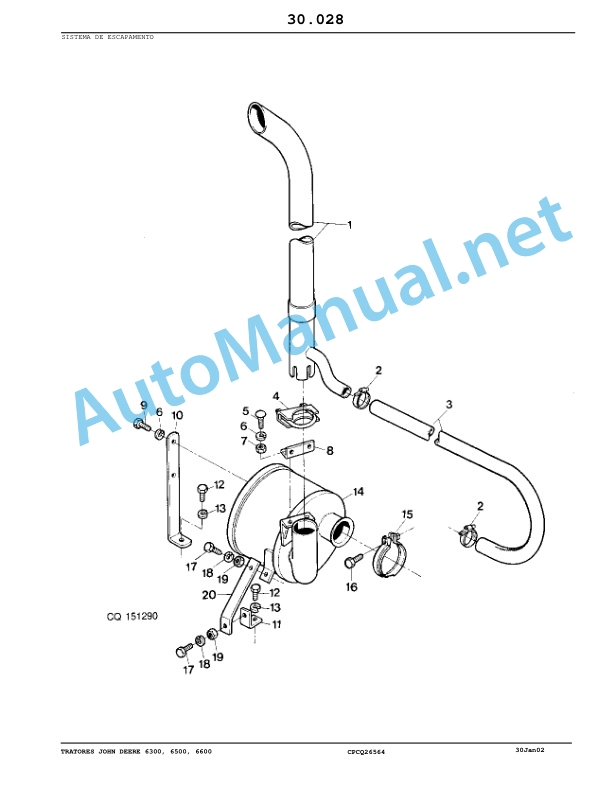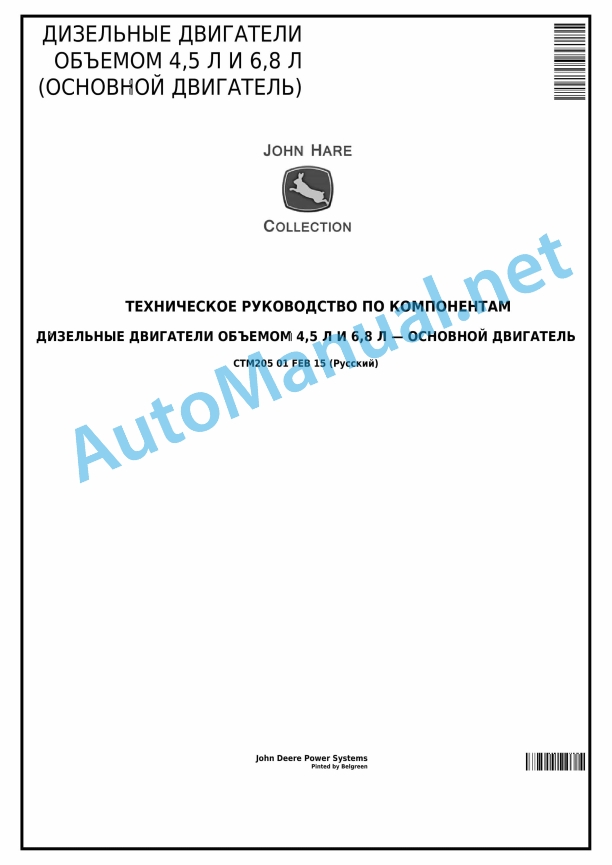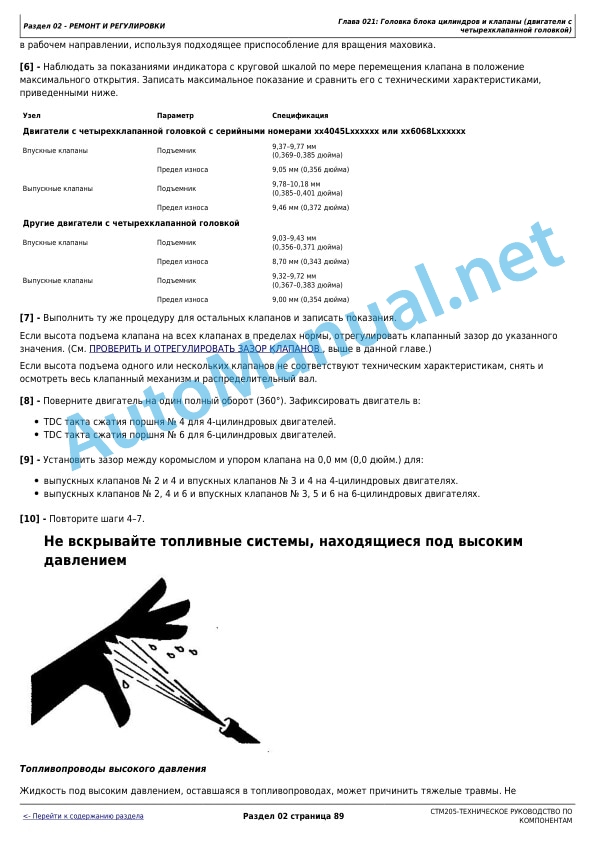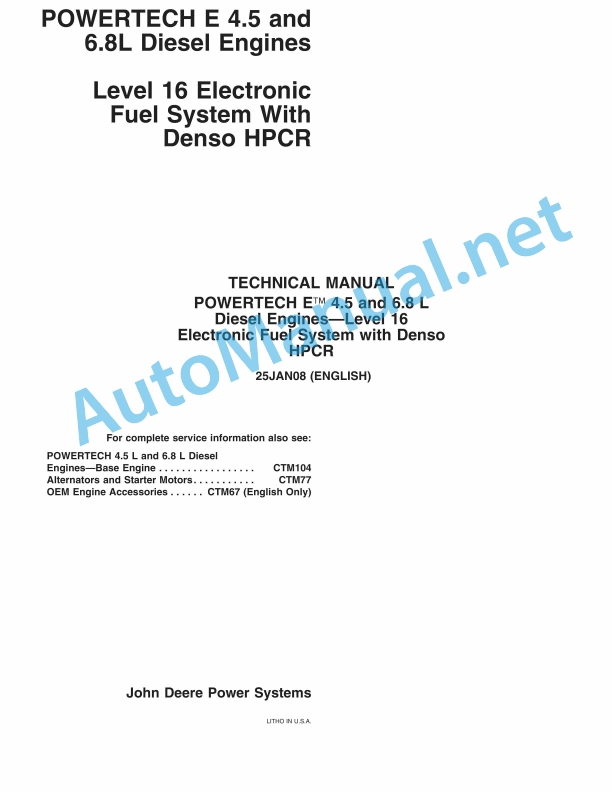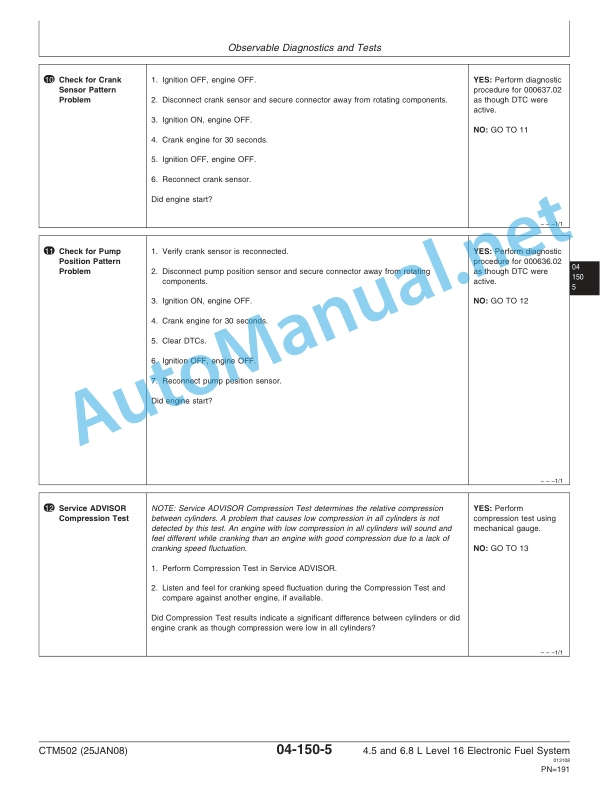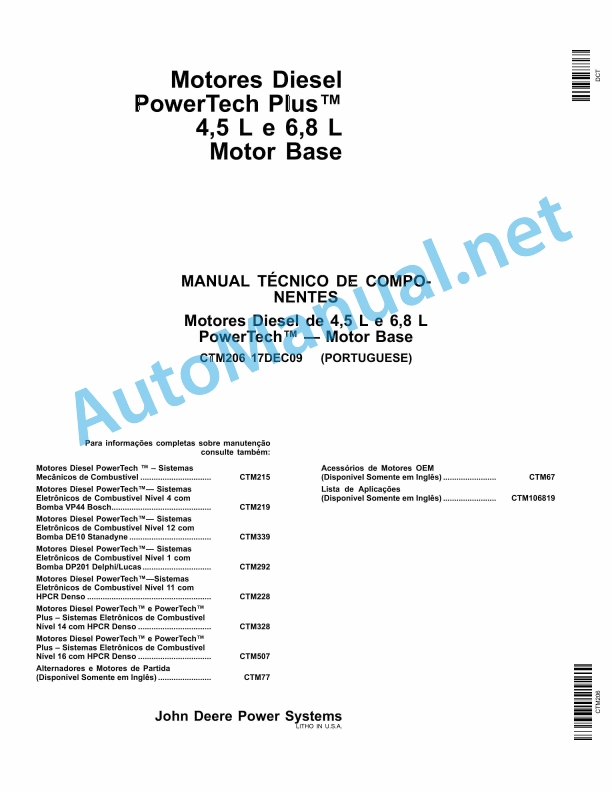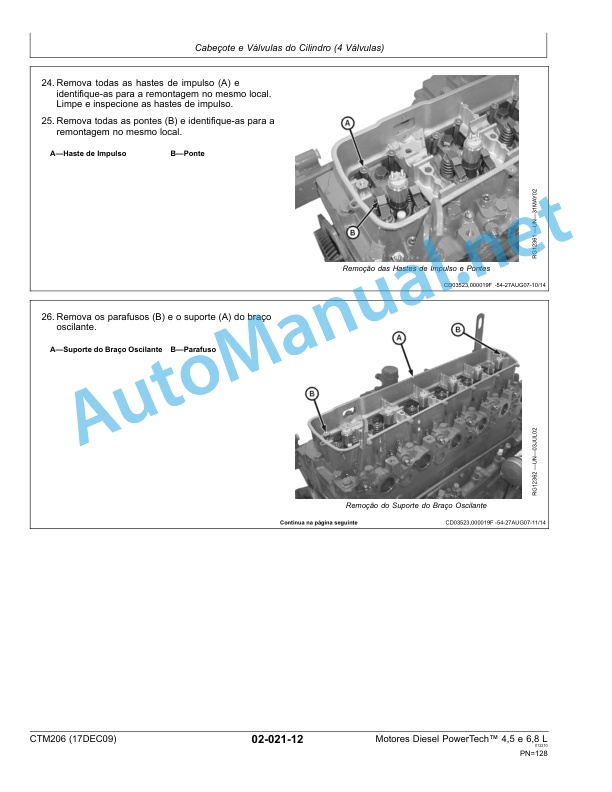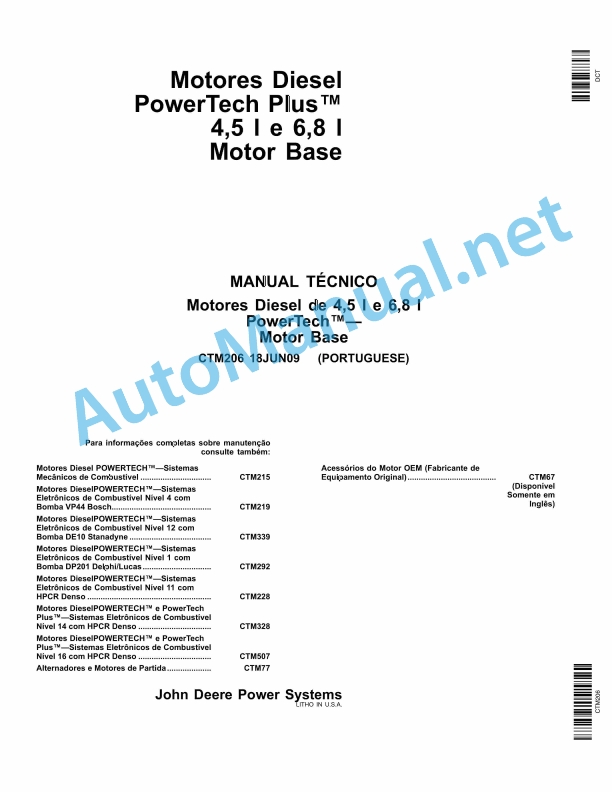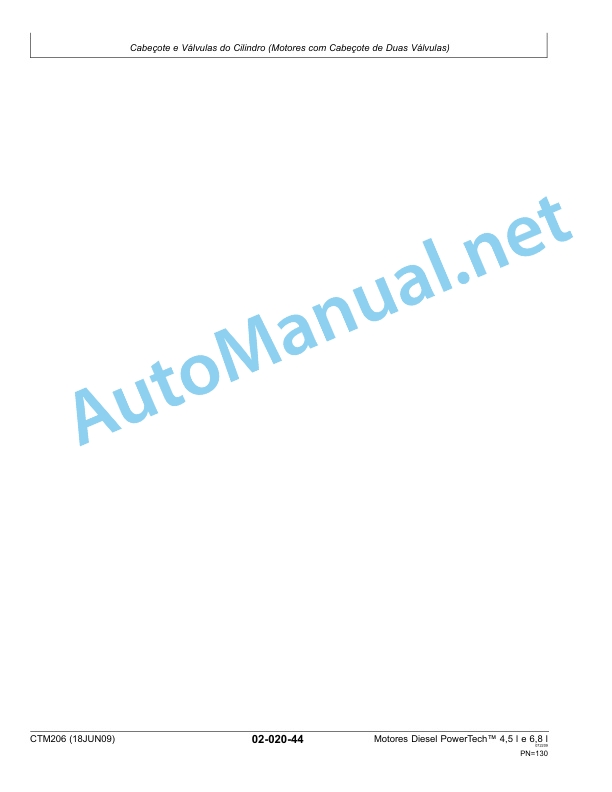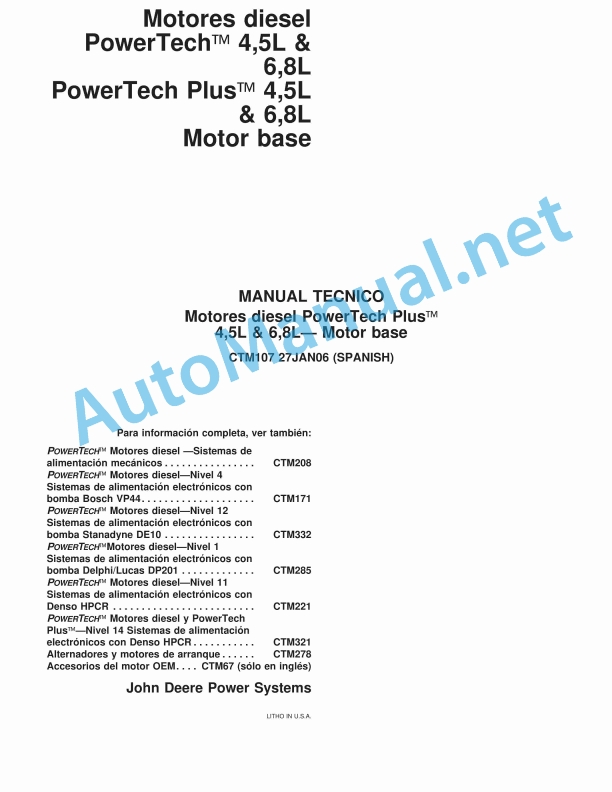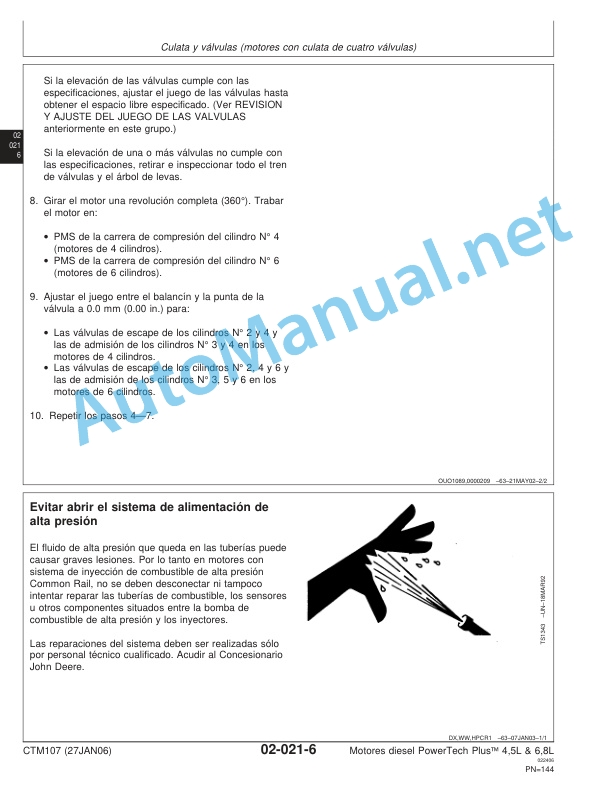Claas Axos 340-310 (A22) Tractors Operator Manual ES
$50.00
- Model: Axos 340-310 (A22) Tractors
- Type Of Manual: Operator Manual
- Language: ES
- Format: PDF(s)
- Size: 42.4 MB
File List:
00 2182 064 0.pdf
00 2199 934 1.pdf
00 2182 064 0.pdf:
AXOS 340-330-320-310
1 Regarding this instruction manual
1.1 Information regarding the instruction manual
1.1.1 Use the user manual
Important information about this user manual
Structuring according to tractor subassemblies
Search and find
Direction signs
Specific terminology
Optional equipment and supplementary equipment
1.1.2 Symbols and instructions
Texts and illustrations
Indication of dangers and warnings
1.1.3 Validity of the user manual
1.1.4 Technical instructions
2 Security
2.1 Safety instructions
2.1.1 Use according to assignment
2.1.2 Use not in accordance with assignment
2.1.3 European regulations
2.1.4 Safety and accident prevention instructions
2.1.5 Driving the tractor
2.1.6 Checking the condition of the tractor
2.1.7 Getting on/off the tractor
Climb aboard the tractor
tractor lowering
2.1.8 Passenger seat
2.1.9 Necessary precautions before start-up
2.1.10 Cabin
Cabin safety structure
Polluted environment
2.1.11 Tool attachment
2.1.12 Adjustment and maintenance operations
Particularities of placing the tractor on lifting supports
2.1.13 Using the front/rear power take-off
2.1.14 Fuel
2.1.15 Engine coolant
2.1.16 Air conditioning
2.1.17 Electrical system
2.1.18 Applications with front loaders
2.1.19 Forestry applications
2.1.20 Work in fixed position
2.1.21 Tools that work at great depth
2.1.22 Twin wheels
2.2 Safety marking on the tractor
2.2.1 General advice regarding safety markings
2.2.2 Warning symbols
2.3 Safety devices
2.3.1 Wheel chock
3 Description of the tractor
3.1 Overview
3.1.1 Left front view
3.1.2 3/4 view of the right rear
3.2 Identification plates and vehicle identification number
3.2.1 Spare parts and technical issues
3.2.2 Tractor nameplate
Tractor identification number
3.2.3 Tractor power label
3.2.4 Motor nameplate
3.2.5 Front axle nameplate
3.2.6 Front hydraulic linkage nameplate
3.2.7 Front power take-off nameplate
3.2.8 Traction hook nameplates
3.2.9 Cab nameplate
Cab nameplate
Supplementary cab nameplate
4 Control and display instruments
4.1 Driver’s cabin/platform
4.1.1 Driving position, cab version
4.1.2 Dashboard, cabin version
4.1.3 “TCE 9” electrohydraulic rear lift controls
4.1.4 Instrument panel
4.1.5 Transmission screen
4.1.6 Manual air conditioning control
4.1.7 Driving position controls
Signal lights and acoustic warning
Rotating flashing lights and emergency lights
Front windshield wipers and washers
4.1.8 Cabin top controls
Work lights
Rear windshield wipers and washers
4.1.9 Power socket for electrical box
4.2 Driver’s platform
4.2.1 Driving position, platform version
4.2.2 Dashboard, platform versio .3 Driving position controls
Signal lights and acoustic warning
Work lights, emergency lights and rotating flashing lights
4.2.4 Power socket for electrical box
4.3 Hydraulic installation
4.3.1 Hydraulic controls
4.4 Electrical/electronic installation
4.4.1 External controls (TCE9 electrohydraulic rear lift)
5 Technical data
5.1 AXOS 340 – 310
5.1.1 Dimensions
Cabin version
Platform version
5.1.2 Weight
Cabin version
Platform version
5.1.3 Engine
5.1.4 Gearbox
5.1.5 Travel speeds
5.1.6 Electrohydraulic duplicator and gearbox with 4 or 5 gears
5.1.7 Mechanical duplicator and gearbox with 4 or 5 gears
5.1.8 Gearbox with 4 or 5 speeds, without duplicator
5.1.9 Rear axle
5.1.10 Front axle
5.1.11 Brakes
5.1.12 Address
5.1.13 Rear hydraulic lift
5.1.14 Front hydraulic lift
5.1.15 Rear hitches
5.1.16 Rear PTO
5.1.17 Front power take-off
5.1.18 Hydraulic circuits
5.1.19 Hydraulic distributor combinations
5.1.20 Electrical circuit
5.1.21 Cabin characteristics
Noise level in the driver’s ears (according to European directive 2009/76)
Noise level in the ears of a passerby (according to European directive 2009/63 Annex VI)
5.1.22 Seat vibration level
5.1.23 Ballast
5.1.24 Maximum allowable towable weights
5.1.25 Load capacities
5.1.26 Lubricants/Hydraulic Oils
5.1.27 Engine coolant
5.1.28 Air conditioning cooling agent
6 Prepare the tractor
6.1 Engine
6.1.1 Fuel
Quality requirement
Particularities of biofuels
Fuel handling
6.1.2 Filling the fuel tank
6.1.3 Aids for starting in cold temperatures
Engine coolant heater
fuel heater
6.2 Framework
6.2.1 AXOS 330310: Front track table
Flange rims
Flange rims
Fixed disc rims
6.2.2 AXOS 330310: Rear track table
Flange rims
Flange rims
Fixed disc rims
6.2.3 AXOS 340: Front track table
Flange rims
Fixed disc rims
6.2.4 AXOS 340: Rear track table
Flange rims
Fixed disc rims
6.2.5 Tire combinations
6.2.6 Front axle track adjustment
6.2.7 Rear axle track adjustment
6.2.8 Adjustment of the rotation stops
Adjustment
6.2.9 General characteristics of the tires
6.2.10 Inflation pressure
Effect on soil compaction
Effect on consumption
6.2.11 Features
Load index
speed index
6.3 Brake
6.3.1 Brake pedal engagement
6.3.2 Hydraulic trailer brake
6.3.3 Trailer pneumatic brake
6.4 Address
6.4.1 Steering column
6.5 Rear linkage
6.5.1 Lifting supports
6.5.2 Upper connecting rod
6.5.3 Stabilizers
Mechanical stabilizers
Self-Locking Stabilizers
6.5.4 Automatic hooks
6.5.5 External controls
With TCE9 electrohydraulic rear lift
With hydraulic rear lift with mechanical control
6.5.6 Attaching/disengaging a tool
Hitch Recommendations
Disengagement
6.6 Front linkage
6.6.1 Front hydraulic lift. Preliminary operations
6.6.2 Mechanical upper connecting rod
6.6.3 Lower cranks
6.6.4 Automatic hooks
6.6.5 Attaching/disengaging a tool
Hitch Recommendations
Disengagement
6.7 Front loader
6.7.1 Mounting the front loader adapter
6.8 Rear PTO
6.8.1 PTO nozzle
6.8.2 Attaching/disengaging a tool
Connecting/disconnecting the rear PTO cardan
Disengagement
6.9 Front power take-off
6.9.1 Attaching/disengaging a tool
Connecting/disconnecting the front power take-off cardan
Disengagement
6.10 Towing device
6.10.1 Recommendations
6.10.2 Calculation of maximum towable load (not including CUNA forks)
6.10.3 Attaching/disengaging a tool
Disengagement
6.10.4 Hitch forks
Manual locking fork
Automatic locking fork
6.10.5 Oscillating bar
Safety device
Jaw tightening
6.10.6 Pull hook
6.11 Rear hydraulic system
6.11.1 Rear pressure taps
Connection/Disconnection of pressure taps
Free return to deposit
6.11.2 Single acting/double acting adjustment
6.12 Electrical/electronic installation
6.12.1 Electrical sockets
Power outlet for electrical box
Exterior shot
6.12.2 Low beam adjustment
6.13 Driver’s cabin/platform
6.13.1 Mirror adjustment
6.13.2 Folding arch
6.13.3 Comfort driver seat adjustment, cab version
6.13.4 Adjustment of the pneumatic driver’s seat (with and without horizontal suspension), cab version
6.13.5 Waterproof driver’s seat adjustment. Platform version tractors
6.13.6 Passenger seat
6.13.7 Installation of a control console in the cabin
6.13.8 Control console cable routing
6.13.9 Compartments
6.14 Attached parts, machine housing
6.14.1 Ballast
6.14.2 Liquid ballast
6.14.3 Balancing the tractor with mounted tools
Summary table
6.14.4 Assembly and disassembly of the front weights
6.14.5 Opening and closing the cover
Opening the engine cover
Engine cover closure
6.14.6 Toolbox
6.15 Transport of the tractor
6.15.1 Transport
6.15.2 Tractor loading and stowage
7 Management
7.1 Engine
7.1.1 Break-in
7.1.2 Engine starting
Preliminary operations
Start up
7.1.3 Accelerator pedal
7.1.4 Hand throttle
7.1.5 Engine stop
7.2 Gears / clutch / cardan shaft
7.2.1 Neutral inverter
7.2.2 Selection of tractor forward direction
“Revershift” electrohydraulic gear reverser
Mechanical gear reverser
recommendations
7.2.3 Clutch pedal
7.2.4 Speed selection
Gear shift lever contactor
7.2.5 Range selection
7.2.6 Duplicator
mechanical duplicator
electrohydraulic duplicator
7.2.7 Tortoise gait
7.2.8 Locking the differentials
7.3 Chassis
7.3.1 Front axle activation
Automatic mode
Permanent mode
7.4 Brake
7.4.1 Service brakes
7.4.2 Handbrake (auxiliparki)
7.5 Mechanical rear hydraulic lift
7.5.1 Position control
7.5.2 Effort control
7.5.3 Mixed control
7.5.4 External controls
7.6 Electronic rear hydraulic lift
7.6.1 Recommendations
7.6.2 Transport security
7.6.3 Unlocking the rear hydraulic lift
7.6.4 Mode selection
7.6.5 Rear hydraulic linkage position control
7.6.6 Rear hydraulic linkage effort control
7.6.7 External controls of the rear hydraulic linkage
7.6.8 Rear hydraulic lift top stop
7.6.9 Lowering speed of the lower linkages of the rear hydraulic linkage
7.6.10 Rear hydraulic lift transport shock absorber
7.7 Front linkage
7.7.1 Use
7.8 Rear PTO
7.8.1 PTO speed selection
7.8.2 Use
Mechanical activation power take-off
PTO with activation of the hydraulic circuit
Restart procedure
7.8.3 Work in fixed position
7.9 Front power take-off
7.9.1 Recommendations
7.9.2 Use
Activation of the front power take-off
7.10 Rear hydraulic system
7.10.1 Associations of controls and rear pressure taps
Distribution block composed of 2 auxiliary hydraulic distributors
Distribution block composed of 3 auxiliary hydraulic distributors
7.10.2 Use of the in-line controls of the auxiliary hydraulic distributors
7.10.3 Cross control
Blocking
7.10.4 Flow regulator
7.10.5 Work in fixed position
7.11 Electrical/electronic installation
7.11.1 Manual circuit breaker
7.12 Driver’s cabin/platform
7.12.1 Instrument panel display
Utilization
7.12.2 Heating. Ventilation. Air conditioning with manual control
Ventilated air flow adjustment
Ventilated air temperature adjustment
Ventilation orientation management
Activation of air cooling
Activation of air recirculation
7.12.3 Ceiling light
8 Incident and solution
8.1 Alarms
8.1.1 Primary alarms
8.1.2 Secondary alarms
8.1.3 Other alarms
8.2 Engine
8.2.1 Failure due to lack of fuel
8.2.2 Startup assistance
Trailer assisted start
Starting assisted by external battery
8.3 Framework
8.3.1 Jack placement
8.3.2 Changing a wheel
8.3.3 Tractor trailer
Trailer with engine off
Trailer with engine running
8.4 Electrical/electronic installation
8.4.1 Fuses and relays
Preheating relay and fuse
Fuse box, cabin version
Fuse box, platform version
8.4.2 Instrument panel calibration
8.4.3 Lights overview
8.5 Attached parts, machine housing
8.5.1 Frontal collision at the front of the tractor
9 Maintenance
9.1 Maintenance instructions
9.1.1 Personal protective equipment
9.1.2 Stopping and securing the tractor
9.1.3 Clean and organize risk areas
9.1.4 Welding instructions
9.1.5 Protection devices on the tractor
9.1.6 Engine
Alternator
Engine lubrication
engine cooling
engine belts
9.1.7 Wheels and tires
9.1.8 Braking system
9.1.9 Pneumatic circuit
9.1.10 Address
9.1.11 Power take-off driven tools
9.1.12 Air conditioning
9.1.13 Hydraulic circuit
9.1.14 Electrical system
9.1.15 Energy accumulators
9.1.16 Spare parts
9.1.17 Greasing
9.1.18 Cleaning/protection
9.1.19 Work at height
9.1.20 Handling of heavy parts
9.1.21 Maintenance operations in the cabin
9.1.22 Lifting the front of the tractor
9.2 Summary of maintenance intervals
9.2.1 According to the national legislation in force in the country of circulation of the tractor
9.2.2 First 10 hours
9.2.3 First 40 hours
9.2.4 First 100 hours
9.2.5 First 500 hours
9.2.6 Every 10 hours
9.2.7 Every 50 hours
9.2.8 Every 50 hours or every week
9.2.9 Every 100 hours
9.2.10 Monthly
9.2.11 Every 400 hours
9.2.12 Every 500 hours
9.2.13 Every 500 hours or every six months
9.2.14 Every 500 hours or annually
9.2.15 Every 1,000 hours
9.2.16 Every 1,500 hours
9.2.17 Every 1,500 hours or annually
9.2.18 Every 1,500 hours or every two years
9.2.19 Every 3,000 hours
9.2.20 Every 4,500 hours or every 5 years
9.3 Greasing scheme
9.3.1 Grease points, 10 h
9.3.2 Grease points, 50 h
9.3.3 Grease points, 100 h
9.3.4 Grease points, 500 h
9.4 Engine maintenance operations
9.4.1 Adjustment of the rocker arms
9.4.2 Elimination of water present in fuel
9.4.3 Changing fuel filters
Prefilter
9.4.4 Check the calibration pressure of the injectors
9.4.5 Bleeding air from the injection circuit
9.4.6 Checking the injection system fittings
9.4.7 Checking the engine oil level
9.4.8 Changing the engine oil
9.4.9 Changing the engine oil filter cartridge
9.4.10 Coolant level control
9.4.11 Cooling circuit tightness check
9.4.12 Changing the engine cooling circuit fluid
9.4.13 Cleaning of refrigerators
9.4.14 Checking the belts
Engine belt configurations
Checking the belts (I) (II) (III) and (IV)
Adjusting the tension of the alternator belts (I)
9.4.15 Changing the alternator belts and the belt with tension roller
Preliminary operations
Changing the belts (I)
Configuration A. Belt change (II): Belt with tension roller
Configuration B. Belt change (III): Air conditioning compressor belt without tension roller
Configuration (C) – Belt change (IV)
Configuration (D)
9.4.16 Checking the tightness of the collectors
9.4.17 Air intake tightness check
9.4.18 Removal of dust accumulated on the engine air filter body
9.4.19 Cleaning the engine air filter
9.4.20 Changing the engine air filter
9.4.21 Changing the air filter and engine safety cartridge
9.5 Gear maintenance operations
9.5.1 Checking the clutch pedal play
9.6 Chassis maintenance work
9.6.1 Checking the front axle differential case oil level
9.6.2 Changing the oil in the front axle differential casing
9.6.3 Changing the front axle vent
9.6.4 Checking the oil level of the front axle final reductions
9.6.5 anging the frt axle final reduction oil
9.6.6 Checking tire inflation pressure
9.6.7 Checking the tightening of the wheel discs on the hubs
9.6.8 Checking the tightening of the wheel discs on the rims
9.6.9 Checking the tightening of the connecting screws
9.6.10 Front axle parallelism check
9.7 Brake maintenance operations
9.7.1 Checking the service brake clearance
9.7.2 Checking the handbrake play
9.7.3 Checking the pneumatic braking connectors
9.7.4 Checking the trailer pneumatic braking system bleed valves
9.7.5 Changing the belt without tensioning roller of the air conditioning compressor
Preliminary operations
9.7.6 Inspection of compressed air tanks
9.8 Hitch device maintenance operations
9.8.1 Checking the tow hook rods
9.8.2 Checking the position of the hitch hook and checking the tightening of the traction hook fixing screws
9.8.3 Checking the wear of the hitch hook and checking the locking of the traction hook
9.8.4 Adjustment of the draw hook rods
9.8.5 Checking fork play
9.9 Rear power take-off maintenance operations
9.9.1 Checking the mechanical power take-off clutch clearance
9.10 Front power take-off maintenance operations
9.10.1 Checking the front power take-off box oil level
9.10.2 Changing the oil in the front power take-off box
9.11 Hydraulic installation maintenance work
9.11.1 Hydraulic circuit control
9.11.2 Checking the hydraulic/transmission oil level
9.11.3 Hydraulic/transmission oil change
9.11.4 Replacing the hydraulic/transmission circuit filter cartridges
High pressure filter
Electrohydraulic inverter filter
Bleeding air from the hydraulic/transmission circuit
9.11.5 Changing the hydraulic shower head
9.11.6 Replacing the rear axle breather
9.11.7 Checking the hydraulic connections of the front and rear hydraulic lifts
9.11.8 Emptying the oil recovery tank
9.11.9 Inspection of hydraulic accumulators
9.11.10 Requalification of hydraulic accumulators
9.12 Electrical/electronic installation maintenance work
9.12.1 Cleaning and greasing the battery terminals
9.13 Cabin/driving position maintenance operations
9.13.1 Cleaning the cabin air filter
9.13.2 Changing the cabin air filter
9.13.3 Cleaning the cabin air recirculation filter
9.13.4 Changing the cabin air recirculation filter
9.13.5 Putting the air conditioning into operation
9.13.6 Recharging the air conditioning circuit
9.13.7 Checking the window washer fluid level
9.14 Bodywork maintenance operations
9.14.1 Cleaning the calender grates
9.14.2 Check the tightening of the front weight fixing screws
9.15 Parking
9.15.1 Parking instructions
Long term parking
New commissioning
10 Service
10.1 AXOS 340 – 310
10.1.1 Spare parts and technical issues
11 Decommissioning and waste disposal
11.1 Information about the machine
11.1.1 Disposal and waste disposal
12 Technical dictionary and abbreviations
12.1 Technical dictionary and abbreviations
12.1.1 Technical terms
12.1.2 Abbreviations
00 2199 934 1.pdf:
AXOS 340-330-320-310
1 Regarding this instruction manual
1.1 Information regarding the instruction manual
1.1.1 Use the user manual
Important information about this user manual
Structuring according to tractor subassemblies
Search and find
Direction signs
Specific terminology
Optional equipment and supplementary equipment
1.1.2 Symbols and instructions
Texts and illustrations
Indication of dangers and warnings
1.1.3 Validity of the user manual
1.1.4 Technical instructions
2 Security
2.1 Safety instructions
2.1.1 Use according to assignment
2.1.2 Use not in accordance with assignment
2.1.3 European regulations
2.1.4 Safety and accident prevention instructions
2.1.5 Driving the tractor
2.1.6 Checking the condition of the tractor
2.1.7 Getting on/off the tractor
Climb aboard the tractor
tractor lowering
2.1.8 Passenger seat
2.1.9 Necessary precautions before start-up
2.1.10 Cabin
Cabin safety structure
Polluted environment
2.1.11 Tool attachment
2.1.12 Adjustment and maintenance work
Particularities of placing the tractor on lifting supports
2.1.13 Using the front/rear power take-off
2.1.14 Fuel
2.1.15 Engine coolant
2.1.16 Air conditioning
2.1.17 Electrical system
2.1.18 Applications with front loaders
2.1.19 Forestry applications
2.1.20 Work in fixed position
2.1.21 Implements that work at great depth
2.1.22 Twin wheels
2.2 Safety marking on the tractor
2.2.1 General advice regarding safety markings
2.2.2 Warning symbols
2.3 Safety devices
2.3.1 Wheel chock
3 Description of the tractor
3.1 Overview
3.1.1 Left front view
3.1.2 3/4 view of the right rear
3.2 Identification plates and vehicle identification number
3.2.1 Tractor nameplate
Tractor identification number
Regulatory tractor type
Tractor serial number
3.2.2 Tractor power label
3.2.3 Motor nameplate
3.2.4 Front axle nameplate
3.2.5 Front hydraulic linkage nameplate
3.2.6 Front power take-off nameplate
3.2.7 Traction hook nameplates
3.2.8 Cabin nameplate
Situation 1
Situation 2
3.2.9 Supplementary cabin nameplate
4 Control and display instruments
4.1 Cabin and driving position
4.1.1 Driving position
4.1.2 Dashboard
4.1.3 “TCE 9” electrohydraulic rear lift controls
4.1.4 Instrument panel
4.1.5 Transmission screen
4.1.6 Manual air conditioning control
4.1.7 Driving position controls
Signal lights and acoustic warning
Depending on equipment: Switching of the low beam headlights
Rotating flashing light and emergency lights
Front windshield wipers and washers
4.1.8 Cap controls
Work lights
Rear windshield wipers and washers
4.1.9 Power socket forctrical box
4.2 Hydraulic installation
4.2.1 Hydraulic controls
4.3 Electrical and electronic system
4.3.1 External controls (TCE9 electrohydraulic rear lift)
5 Technical data
5.1 AXOS 340 – 310
5.1.1 Dimensions
5.1.2 Engine
5.1.3 Weight
5.1.4 Gearbox
5.1.5 Travel speeds
5.1.6 Electrohydraulic duplicator and gearbox with 5 gears
5.1.7 Mechanical duplicator and gearbox with 5 gears
5.1.8 Gearbox with 5 gears – Without duplicator
5.1.9 Rear axle
5.1.10 Front axle
5.1.11 Brakes
5.1.12 Address
5.1.13 Rear lift
5.1.14 Front linkage
5.1.15 Rear hitches
5.1.16 Rear PTO
5.1.17 Front power take-off
5.1.18 Hydraulic circuit
5.1.19 Hydraulic distributor combinations
5.1.20 Electrical circuit
5.1.21 Cabin characteristics
Sound level in the driver’s ears (according to European directive 2009/76)
Sound level in thears of a passerby (according to European directive 2009/63 Annex VI)
5.1.22 Seat vibration level 5.1.23 Ballast
5.1.24 Maximum allowable towable masses
5.1.25 Load capacities
5.1.26 Hydraulic lubricants/oils
5.1.27 Engine coolant
5.1.28 Air conditioning cooling agent
6 Prepare the tractor
6.1 Engine
6.1.1 Fuel
Quality requirement
Particularities of biofuels
Fuel handling
6.1.2 Filling the fuel tank
6.1.3 Aids for starting in cold temperatures
Engine coolant heater
fuel heater
6.2 Framework
6.2.1 AXOS 330-310: Front track table
Flange rims
Fixed disc rims
6.2.2 AXOS 330310: Rear track table
Flange rims
Fixed disc rims
6.2.3 AXOS 340: Front track table
Flange rims
Fixed disc rims
6.2.4 AXOS 340: Rear track table
Flange rims
Fixed disc rims
6.2.5 Tire combinations
6.2.6 Front axle track adjustment
6.2.7 Rear axle track adjustment
6.2.8 Adjustment of the rotation stops
Adjustment
6.2.9 General characteristics of the tires
6.2.10 Inflation pressure
Effect on soil compaction
Effect on consumption
6.2.11 Features
Load index
speed index
6.3 Brake
6.3.1 Brake pedal engagement
6.3.2 Hydraulic trailer brake
6.3.3 Trailer pneumatic brake
6.4 Address
6.4.1 Steering column
6.5 Rear linkage
6.5.1 Lifting supports
6.5.2 Upper connecting rod
6.5.3 Stabilizers
Mechanical stabilizers
6.5.4 Automatic hooks
6.5.5 External controls
With TCE9 electrohydraulic rear lift
With mechanically controlled rear linkage
6.5.6 Attaching/disengaging a tool
Hitch Recommendations
Disengagement
6.6 Front linkage
6.6.1 Front hydraulic lift. Preliminary operations
6.6.2 Mechanical upper connecting rod
6.6.3 Lower cranks
6.6.4 Automatic hooks
6.6.5 Attaching/disengaging a tool
Hitch Recommendations
Disengagement
6.7 Front loader
6.7.1 Mounting the front loader adapter
6.8 Rear PTO
6.8.1 Replacing the rear power take-off terminal
Disassembly of the rear power take-off terminal
Rear PTO terminal assembly
6.8.2 Attaching/disengaging a tool
Connecting/disconnecting the rear PTO cardan
Disengagement
6.9 Front power take-off
6.9.1 Hitching/unhitching an implement
Connecting/disconnecting the front power take-off cardan
Disengagement
6.10 Towing device
6.10.1 Recommendations
6.10.2 Calculation of maximum towable load (not including CUNA forks)
6.10.3 Hitching/unhitching an implement
Disengagement
6.10.4 Hitch forks
Manual locking fork
Automatic locking fork
6.10.5 Oscillating bar
Safety device
Jaw tightening
6.10.6 Pull hook
6.11 Rear hydraulic system
6.11.1 Rear pressure taps
Connection/Disconnection of pressure taps
Free return to deposit
6.11.2 Single acting/double acting adjustment
6.12 Electrical and electronic system
6.12.1 Electrical sockets
Power outlet for electrical box
Exterior shot
6.12.2 Low beam adjustment
6.13 Cabin and driving position
6.13.1 Mirror adjustment
6.13.2 Comfort driver seat adjustment
6.13.3 Adjustment of the pneumatic driver’s seat (with and without horizontal suspension)
6.13.4 Passenger seat
6.13.5 Installation of a control console in the cabin
6.13.6 Route of the cables of a control console
6.13.7 Compartments
6.14 Assembly and body parts
6.14.1 Ballast
6.14.2 Liquid ballast
6.14.3 Balancing the tractor with mounted implements
Summary table
6.14.4 Assembly and disassembly of the front masses
6.14.5 Opening and closing the cover
Opening the engine cover
Engine cover closure
6.14.6 Toolbox
6.15 Transport of the tractor
6.15.1 Transport
6.15.2 Tractor loading
7 Management
7.1 Engine
7.1.1 Break-in
7.1.2 Engine starting
Preliminary operations
Start up
recommendations
7.1.3 Accelerator pedal
7.1.4 Hand throttle
7.1.5 Engine stop
7.2 Transmission, clutch and cardan shaft
7.2.1 Neutral inverter
7.2.2 Selection of tractor forward direction
“Revershift” electrohydraulic gear reverser
Mechanical gear reverser
recommendations
7.2.3 Clutch pedal
7.2.4 Speed selection
Gear shift lever contactor
7.2.5 Selection of speed ranges
7.2.6 Duplicator
mechanical duplicator
electrohydraulic duplicator
7.2.7 Tortoise gait
7.2.8 Locking the differentials
7.3 Chassis
7.3.1 Front axle activation
Automatic mode
Permanent mode
7.4 Brake
7.4.1 Service brakes
7.4.2 Handbrake (auxiliary and parking brake)
7.5 Mechanical rear hydraulic lift
7.5.1 Position control
7.5.2 Effort control
7.5.3 Mixed control
7.5.4 External controls
7.6 Ec rear hydraulic lift
7.6.1 Recommendations
7.6.2 Transport security
7.6.3 Unlocking the raulic lift
7.6.4 Mode selection
7.6.5 Rear hydraulic linkage position control
7.6.6 Rear hydraulic linkage effort control
7.6.7 External controls of the rear hydraulic linkage
7.6.8 Rear hydraulic lift top stop
7.6.9 Lowering speed of the lower linkages of the rear hydraulic linkage
7.6.10 Rear hydraulic lift transport shock absorber
7.7 Front linkage
7.7.1 Use
7.8 Rear PTO
7.8.1 PTO speed selection
7.8.2 Use
Mechanical activation power take-off
Hydraulic activation power take-off
Restart procedure
7.8.3 Work in fixed position
7.9 Front power take-off
7.9.1 Recommendations
7.9.2 Use
Activation of the front power take-off
7.10 Rear hydraulic system
7.10.1 Associations of controls and rear pressure taps
Distribution block composed of two auxiliary hydraulic distributors
Distribution block composed of three auxiliary hydraulic distributors
7.10.2 Use of the in-line controls of the auxiliary hydraulic distributors
7.10.3 Flow regulator
7.10.4 Work in fixed position
7.11 Electrical and electronic system
7.11.1 Manual circuit breaker
7.12 Cabin and driving position
7.12.1 Instrument panel display
Utilization
Setting the clock
7.12.2 Heating. Ventilation. Air conditioning with manual control
Ventilated air flow adjustment
Ventilated air temperature adjustment
Ventilation orientation management
Activation of air cooling
Activation of air recirculation
7.12.3 Ceiling light
8 Incident and solution
8.1 Alarms
8.1.1 Primary alarms
8.1.2 Secondary alarms
8.1.3 Other alarms
8.2 Engine
8.2.1 Failure due to lack of fuel
8.2.2 Startup assistance
Tow-assisted start
Starting assisted by external battery
8.3 Framework
8.3.1 Jack placement
8.3.2 Changing a wheel
8.3.3 Tractor trailer
Trailer with engine off
Trailer with engine running
8.4 Electrical and electronic system
8.4.1 Fuses and relays
Preheating relay and fuse
Fuse box
8.4.2 Instrument panel calibration
8.4.3 Lights overview
8.5 Assembly and body parts
8.5.1 Frontal collision at the front of the tractor
9 Maintenance
9.1 Maintenance instructions
9.1.1 Personal protective equipment
9.1.2 Stopping and securing the tractor
9.1.3 Clean and organize risk areas
9.1.4 Welding instructions
9.1.5 Protection devices on the tractor
9.1.6 Engine
Alternator
Engine lubrication
engine cooling
engine belts
9.1.7 Wheels and tires
9.1.8 Braking system
9.1.9 Pneumatic circuit
9.1.10 Address
9.1.11 PTO driven implements
9.1.12 Air conditioning
9.1.13 Hydraulic circuit
9.1.14 Electrical system
9.1.15 Energy accumulators
9.1.16 Spare parts
9.1.17 Greasing
9.1.18 Cleaning/protection
9.1.19 Work at height
9.1.20 Handling of heavy parts
9.1.21 Maintenance operations in the cabin
9.1.22 Lifting the front of the tractor
9.2 Summary of maintenance intervals
9.2.1 Management of maintenance intervals
9.2.2 First 10 hours
9.2.3 First 40 hours
9.2.4 First 100 hours
9.2.5 First 500 hours
9.2.6 Every 10 hours
9.2.7 Every 50 hours
9.2.8 Every 50 hours or every week
9.2.9 Every 100 hours
9.2.10 Monthly
9.2.11 Every 400 hours
9.2.12 Every 500 hours
9.2.13 Every 500 hours or every six months
9.2.14 Every 500 hours or annually
9.2.15 Every 1000 hours
9.2.16 Every 1,500 hours
9.2.17 Every 1,500 hours or annually
9.2.18 Every 1,500 hours or every two years
9.2.19 Every 3000 hours
9.2.20 Every 4,500 hours or every 5 years
9.3 Greasing scheme
9.3.1 Grease points, 10 h
9.3.2 Grease points, 50 h
9.3.3 Grease points, 100 h
9.3.4 Grease points, 500 h
9.4 Engine maintenance operations
9.4.1 Adjustment of the rocker arms
9.4.2 Elimination of water present in fuel
9.4.3 Changing fuel filters
Prefilter
9.4.4 Check the calibration pressure of the injectors
9.4.5 Bleeding air from the injection circuit
9.4.6 Checking the injection system fittings
9.4.7 Checking the engine oil level
9.4.8 Changing the engine oil
9.4.9 Changing the engine oil filter cartridge
9.4.10 Coolant level control
9.4.11 Cooling circuit tightness check
9.4.12 Changing the engine cooling circuit fluid
9.4.13 Cleaning of refrigerators
9.4.14 Checking the tightness of the collectors
9.4.15 Air intake tightness check
9.4.16 Removal of dust accumulated on the engine air filter body
9.4.17 Cleaning the engine air filter
9.4.18 Changing the engine air filter
9.4.19 Changing the air filter and engine safety cartridge
9.5 Gear maintenance operations
9.5.1 Checking the clutch pedal play
9.6 Chassis maintenance work
9.6.1 Checking the
John Deere Parts Catalog PDF
John Deere Tractors 7500 Parts Catalog CPCQ26568 30 Jan 02 Portuguese
John Deere Repair Technical Manual PDF
John Deere Diesel Engines POWERTECH 2.9 L Component Technical Manual CTM126 Spanish
John Deere Repair Technical Manual PDF
John Deere Parts Catalog PDF
John Deere Harvesters 8500 and 8700 Parts Catalog CPCQ24910 Spanish
John Deere Parts Catalog PDF
John Deere Tractors 6300, 6500, and 6600 Parts Catalog CQ26564 (29SET05) Portuguese
John Deere Repair Technical Manual PDF
John Deere Repair Technical Manual PDF
John Deere POWERTECH E 4.5 and 6.8 L Diesel Engines TECHNICAL MANUAL 25JAN08
John Deere Repair Technical Manual PDF
John Deere Repair Technical Manual PDF
John Deere Repair Technical Manual PDF
